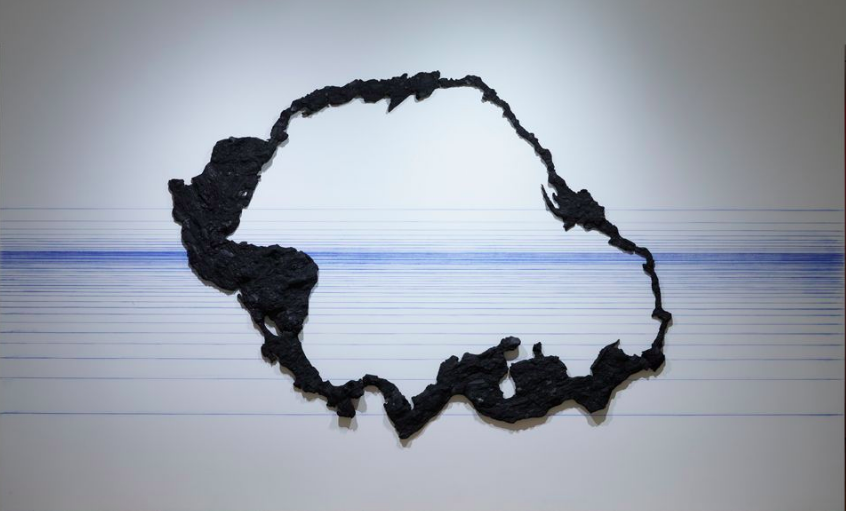TERESITA FERNÁNDEZ EXHIBITS MAELSTROM: A VISUAL ESSAY AT LEHMANN MAUPIN NEW YORK
This exhibition will feature a new series of monumental sculptures and installations that unapologetically visualize the enduring violence and devastation ignited by colonization. Focusing on the Caribbean archipelago, the first point of colonial contact in the Americas, Fernández challenges us to consider a more nuanced reading of people and place, one that looks beyond dominant, continental narratives and instead considers the region as emblematic of an expansive and decentralized state of mind.

The artist conjures images of catastrophic weather and natural disasters as metaphors for centuries of injustice, U.S. military intervention, ecological destruction, and systemic oppression as a means of reflecting on the sociopolitical turmoil and abandon to which the region and its populations have been (and continue to be) subjected.
By evoking the generative forces of nature, Fernández implements a redemptive quality that counters reductive and exoticized clichés of the region often vulgarly associated with tropical paradise and leisure. Poignantly, the word Caribbean comes from the indigenous Táino (Arawak) word Carib, which means “human being.” This exhibition seeks to expose how the world’s wealth has been generated by the genocide of indigenous people, the enslaving of Africans via the Middle Passage, and the extraction of natural and human resources that grew out of this particular locus. Fernández subverts the way these islands exist in the dominant collective imagination—as small in physical scale and periphery—and instead proposes an immense and far-reaching diasporic matrix.
In addition to her major installation within the main gallery, Fernández has created an intimate, immersive installation, Hurakán, in the lower level gallery, that references the systemic exploitation of women’s bodies particular to the Caribbean region. The walls of the gallery are covered with hand drawn horizontal lines rising and falling, echoing water tables or tides. Along a single, eye-level horizon line, 20 intimate 6 x 8 inch works surround the viewer, depicting colorful abstractions that suggest aerial weather patterns and resemble island-like embryos. The title of the series, Hurakán, is an indigenous Taíno word for god of the storm, which was adopted by Spanish colonizers to refer to the seasonal storms specific to the region. In 1953, the United States began using female names for storms, each of Fernández’s work bears the name of an historic hurricane as its subtitle, e.g. Hurakán(Maria), Hurakán(Paloma), Hurakán(Nana), and Hurakán(Flora). Here, Fernández makes pointed reference to both the use of women’s names for catastrophic weather events and the violent history of Puerto Rican women who were unknowingly used to test and develop the birth control pill under the support of Margaret Sanger. Paradoxically, Margaret Sanger is celebrated in the US as a feminist who helped liberate American women to take control of their reproductive rights, even while being connected to the practice of eugenics.
Since the 1950s, Puerto Rico (the oldest existing colony) has been used as an island laboratory for the U.S. eugenics movement that was developed to control the growth of “unwanted” populations and fast track FDA approval for human testing of experimental drugs, including many forms of contraception. Tests and procedures (including sterilization) were performed on victims who were often unaware, uninformed, and powerless against the physicians who were charged with “treating” them. By conflating the early practice of naming destructive hurricanes after women with those who suffered invasive and traumatic experimental medical procedures, Fernández poetically draws a connection between the unspoken abuse inflicted on both the land and on women’s bodies. Also included in the installation is Archipelago(Cervix), a wall sculpture made of solid charcoal composed of all the individual island shapes of the Caribbean archipelago, assembled into an abstracted daisy-chain. Resembling a portal, or cervix, this work directly alludes to the female body and the reproductive violence women of the region have endured at the hands of imperial power.
Teresita Fernández (b. 1968, Miami; lives in New York) is a conceptual artist best known for her immersive, sensuous sculptures and monumental public art. Her work is characterized by an interest in perception and the psychology of looking, and her immersive, large-scale works are often inspired by a rethinking of landscape and place, as well as by diverse historical and cultural references. Often referencing the natural world, Fernández’s conceptual practice emphasizes the connection between place and material; using gold, graphite, iron-ore and other minerals that have loaded historical ties to colonization and the violence embedded in landscape. Her work is characterized by a quiet unraveling of place, power, visibility, and erasure that prompts an intimate experience for individual viewers.
In 2011, Teresita Fernández was appointed by President Barack Obama to serve on the U.S. Commission of Fine Arts. She is the first Latina to serve on this 100-year-old federal panel that advises the president and Congress on national matters of design and aesthetics. Teresita Fernández received a BFA from Florida International University, Miami, in 1990 and an MFA from Virginia Commonwealth University, Richmond, in 1992. She is a MacArthur Foundation Fellow (2005) and the recipient of numerous awards.
Fernández’s work is featured in numerous international public and private collections in the United States, France, Spain, Germany, Israel and Japan. And solo exhibitions of her work have been organized at the Phoenix Art Museum, Phoenix, AZ (2020); Pérez Art Museum Miami, Miami Florida (2019); Harvard University, Boston, MA (2018); and other institutions in the Unites States and Europe. In 2021, Fernández will be installing a monumental, outdoor sculpture titled Paradise Parados on the rooftop of the BAM Harvey Theater in Brooklyn, NY.




